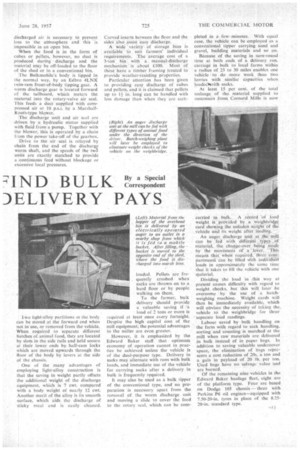To the farmer, bulk delivery should provide a valuable saving
Page 61

Page 62

If you've noticed an error in this article please click here to report it so we can fix it.
if 'a load of 2 tons or more is required at least once every fortnight. Despite the high capital cost of the mill equipment; the potential advantages to the miller are even greater.
However, it is emphasized by the Edward Baker staff that optimum economy of operation cannot in practice be achieved unless the vehicle is of the dual-purpose type. Delivery in sacks may alternate with runs with bulk loads, and immediate use of the vehicle for carrying sacks after a delivery in bulk is frequently required.
It may also be used as a bulk tipper of the conventional type, and no preparation is necessary apart from the removal of the worm discharge unit and moving a slide to cover the feed to the rotary seal, which can be corn
pleted its a few minutes. With equal ease, the vehicle can be employed as a conventional tipper carrying sand and gravel, building materials and so on.
Because of the saving in turn-round time at both ends of a delivery run, carriage in bulk to local farms Within a radius of 25 to 30 miles enables one vehicle to do -more work than two. lorries with similar capacities when loadecAvith sacks.
At least 15 per cent, of the total totTnage. of the. material supplied to customers from Cornard Mills is now
carried in bulk. A record 'of load weight is preVided by a Weighbridge _ .
card showing the unladen weight of the vehicle and its weight after loading. • An auger discharge unit at the Mill. can be led with different . types of Material,. the change-over being made by the inoVernent of a • lever. _This means that when required, three coalpartmenti can be filled With iitdividuitl loads in approximately the same time that it takes to fill the vehicle with one material.
Dividing the load in -this way at present causes difficulty with regard 10 weight checks, but this will later be overcome by the use of a batchweighing machine. Weight cards will then be immediately available, which will obviate the necessity of taking the. vehicle to the weighbridge for three separate load readings.
Labour saved by bulk handling on the farm with regard to sack handling, sorting and counting is matched at the mill when raw materials are delivered in bulk instead of in paper bags. In addition to saving valuable undercover space, the elimination of bags represents a cost reduction of 20s, a ton and a gain in payload of 20 lb. per ton. Used bags have no salvage value and are burned.
Of the remaining nine vehicles in the Edward Baker haulage fleet, eight are of the platform type. Four are based on Dodge 105 chassis — three with Perkins P6 oil engines—equipped with 7.50-20-in. tyres in place of the 8.2520-in, standard type. An Albion Chieftain 7-boner is mainly engaged on long-distance work, including runs to the south of London. Four petrol-cngined Morris Commercial 5-tonners, which are the oldest vehicles in the fleet,' are chiefly employed for shorter deliveries.
Back-loads on the London runs include flour and raw materials, and the vehicles seldom return without a full load. The tonnage carried by the 11 vehicles averages 20,000 a year. , Total mileage covered by the fleet last year was 184,000, individual mileages up to more than 25.000 being recorded. In the previous year, the total mileage was 209,000, compared with a mileage of 157,000 in 1954-1955.
The proportion of the total tonnage carried by road to that transported by rail is approximately 8 to 1. The C-licence fleet handles 90 per cent. of the road traffic. The petrol-engined Dodge chassis is equipped with a light-alloy tipping body for the carriage of bulk grain, and the Albion platform lorry also has an aluminium body, both being of Duramin manufacture. Light-alloy body construction is favoured by Mr. Baker on account of its long wearing properties, and it is probable that the majority of replacement vehicles will be equipped with similar bodies.
Training the Bulkmobile drivers to operate the discharge gear has not presented difficulties. The drivers are mainly local men having a detailed knowledge of the farmers' storage problems. A sense of responsibility for the operation of their vehicles is encouraged by adhering, whenever possible, to the one driver, one vehicle, rule.
Maintenance of the Edward Baker fleet has been in the hands of local garage proprietors. Messrs. 0. and B. H. Bloyes and Sons„of Sudbury, since the horse-and-cart days, and decisions regarding repairs and overhauls arc their responsibility. In the event of suspected, or actual, mechanical trouble the driver reports the defect or symptoms to the garage for immediate attention.
In an emergency, repairs are performed at the week-end, and the provision of a spare vehicle, surplus to average requirements, normally gives freedom from any interruption of fleet operations.
New piston rings are fitted when oil consumption becomes excessive, and when a major overhaul of the engine is required the vehicle is withdrawn from service for about 10 days so that an necessary chassis repair work can be performed, and the body repainted at the same time.








































































































































